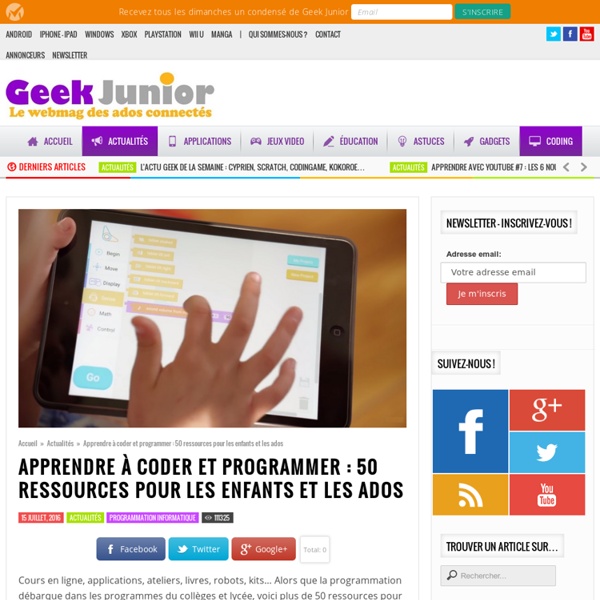



http://www.geekjunior.fr/apprendre-a-coder-programmer-50-ressources-enfant-ados-4376/
Related: apprentissage programmation • CODER • Code et programmation à l'écoleElementary - NEW! WeDo 2.0 Make science come to life Your second- through fourth-graders can gain a deeper insight into science when you use WeDo 2.0 to create engaging, high impact lessons. The hands-on tools encourage pupils to get involved in science exploration by asking questions, analyzing data and communicating their findings, while the curriculum pack covers real science practices linked to the Next Generation Science Standards, including gathering evidence, carrying out investigations and designing prototypes. The core set comes with a programmable Smarthub, motor, two sensors and 280 building elements, plus software which includes one Get Started Project, delivering an introductory experience to the resource.
coding The children have been very interested in maps lately; they create them at our writing table and use them in their dramatic play, refer to printed maps during outside time as they run and ride around on the tricycles, and talk about hiding treasure in our classroom and creating maps to help others find it. They are curious about places in our school and the hallways we need to take to get there. As I reflected upon their genuine interest in location and maps, I thought it was the perfect time to introduce them to coding.
Tech Tips for Teachers: 3 Ways to Use QR Codes in the Classroom Although QR codes have long since lost their shiny, new glow, the technology hasn’t lost its value in education. The rise of one-to-one computing and bring-your-own-device programs in K–12 schools means students access digital learning tools more than ever before. And QR codes, which launch websites with the click of a button, make it so students can spend more time learning and less time typing out complicated URLs. Here are three specific uses for QR codes in the classroom, curated from educators around the web:
7 Fun and Creative Apps and Websites That Teach Kids to Code These iOS and Web Apps are Visually Oriented and Kid-Friendly and Help to Build Critical Logic and Problem Solving Skills Computer coding is becoming an increasingly popular activity for today’s technology oriented kids. Even kids who do not plan to grow up and become computer programmers are enjoying the control and autonomy that coding delivers. Build Your Own Mini Mars Rover With These Brilliant, NASA-Approved Blocks The littleBits Space Kit is a box of Lego-like components that allow anyone to conduct NASA-approved experiments. littleBits You can build miniature, but functioning, versions of NASA’s famous machines like this satellite.
Learning Inland #CSforALL Summit On the heels of the White House Computer Science Summit, the Inland Code Consortium is pleased to announce the Inland CSforALL Summit.Please join us for this exciting event focussed around promoting Computer Science (CS) Education in our region. Representatives from industry, government, K-12 education, and higher education will discuss the... Read More need for CS education, the current status of our region, and future focus. Special Guest Speakers Include: Maynard Holliday, Special Assistant to the Under Secretary of Defense Acquisition, Technology & Logistics Lea Deesing, Chief Innovation Officer for the City of Riverside Jennifer Vaden Barth, Google inc. Vivian Chan, Girls Who Code Leslie Aaronson, National Center for Women and Information Technology Debra Richardson, Donald Bren School of Information and Computer Science, UCI Peter Khooshabeh, Army Research Laboratories Julie Flapan, Alliance for CA Computing Education for Students and Schools Read Less
Routing and Deadlock - Computer Science Unplugged Computer networks are based on passing messages from computer to computer. This sounds simple in principle, but in practice all sorts of contention and bottlenecks can occur. This activity gives some first hand experience of such issues, with a game for a group of students. Activity description (PDF) The Top Five Unexpected Benefits of Robotics in the Classroom By Aaron Maurer As teachers, we’re well aware that STEM education is essential in preparing students for today’s world of non-stop innovation. In my 13 years of teaching I’ve seen many curriculum fads come and go, but the use of robotics in the classroom has proven to be a consistent and surefire way to teach students the STEM skills needed to prepare them for the future job market.
ScratchX What is ScratchX? ScratchX is a platform that enables people to test experimental functionality built by developers for the visual programming language Scratch. What's the difference between Scratch and ScratchX? kidsCODEjeunesse Kids Code Jeunesse offers a range of workshops designed to meet any educator’s level of experience and enthusiasm. For educators who aren’t quite sure what code even is, or whether it’s something they would like to try out in a classroom, we offer free two-hour introductory activities that require no experience and few resources.These tutorials have been designed to build confidence and transfer skills from the classroom to the coding environment. If you’ve learned to read, write, do basic math, organize a routine and solve puzzles, you probably already know more about code than you realize!
Programming mBot with App Inventor 2 ~ Web Tools Review I've recently purchased a robot, based on a board that is Arduino Uno compatibile, called mBot (here you can find it on Amazon Italy). It has a lot of interesting features that make it suitable for teaching, and its price is really interesting (nearly 80 euros/80 US dollars). STEM vs. STEAM: Why The "A" Makes a Difference Science, technology, engineering, and math (STEM) subjects are the focal point of popular integrated learning systems. However, voices are calling out for the “A” in “arts” to turn STEM into STEAM. What does the debate involve, and what do educators and students think about it? Image via Flickr by Jeff Pioquinto, SJ The National Math + Science Initiative points out some numbers that highlight STEM’s essential role in the United States’ education system.